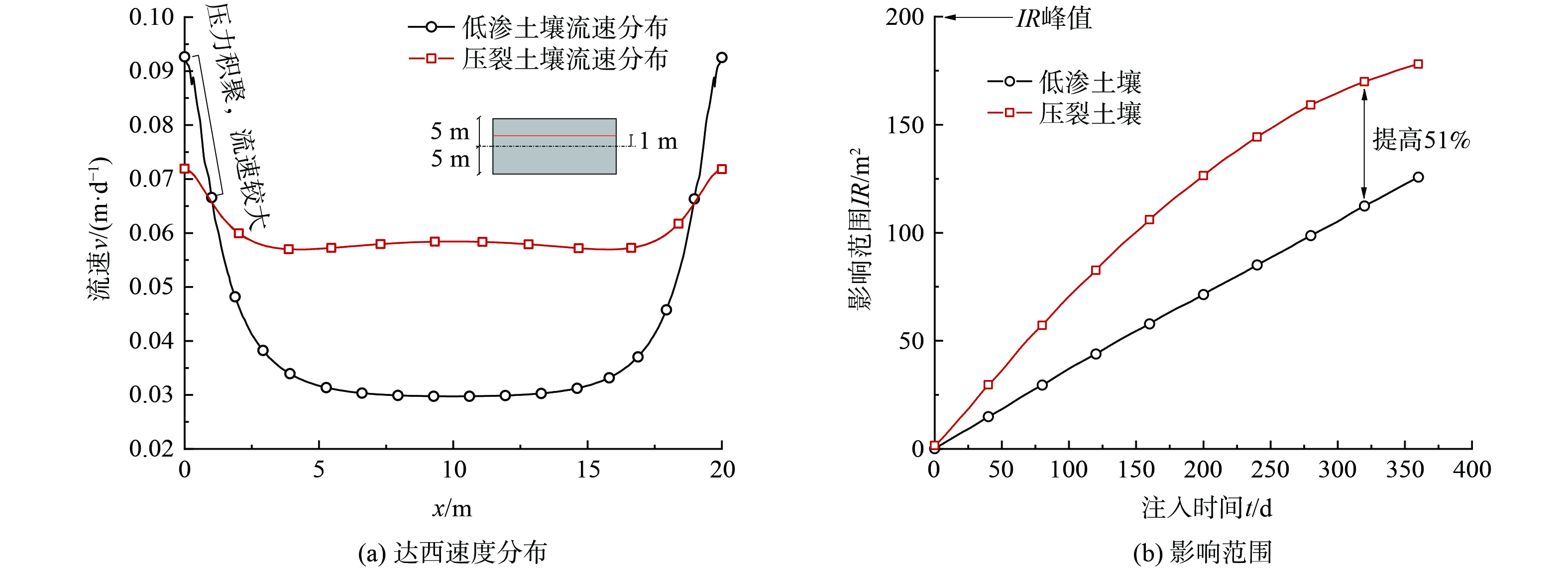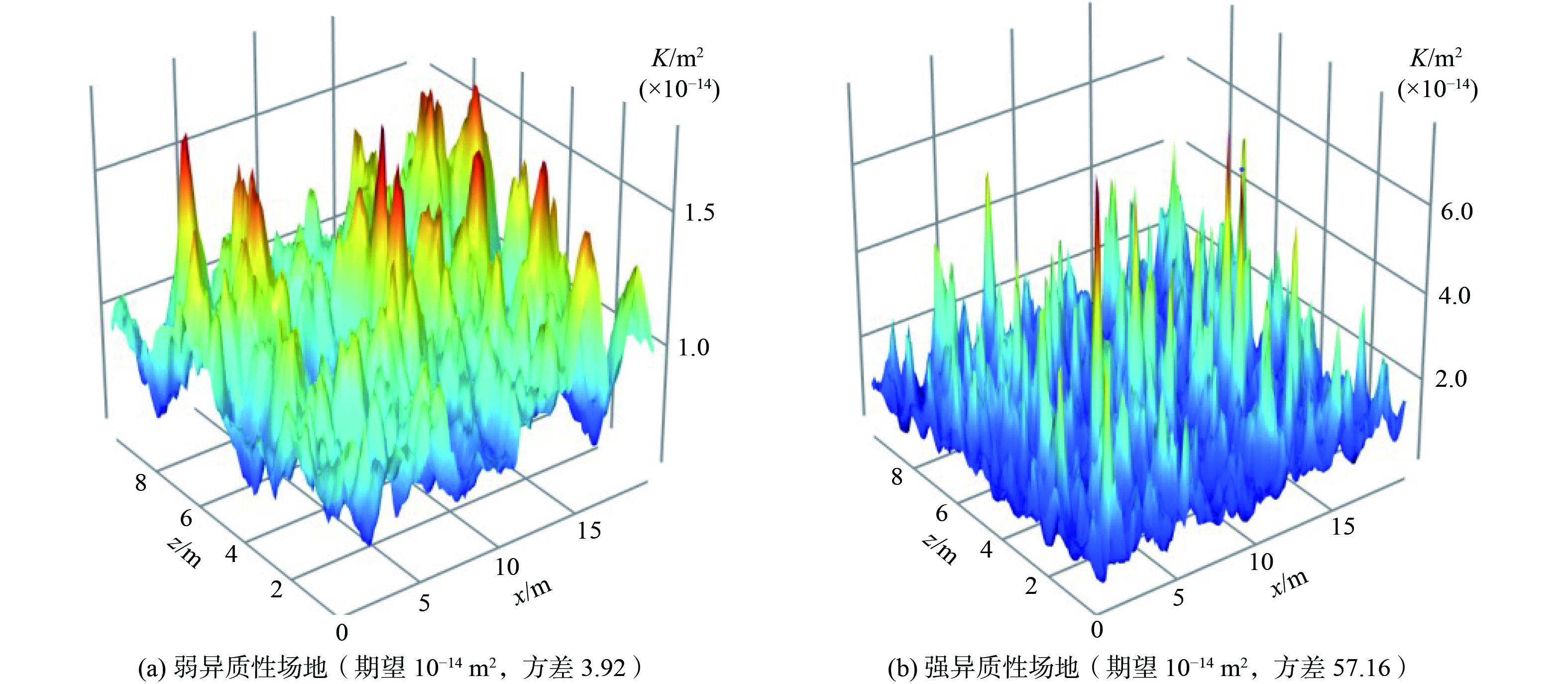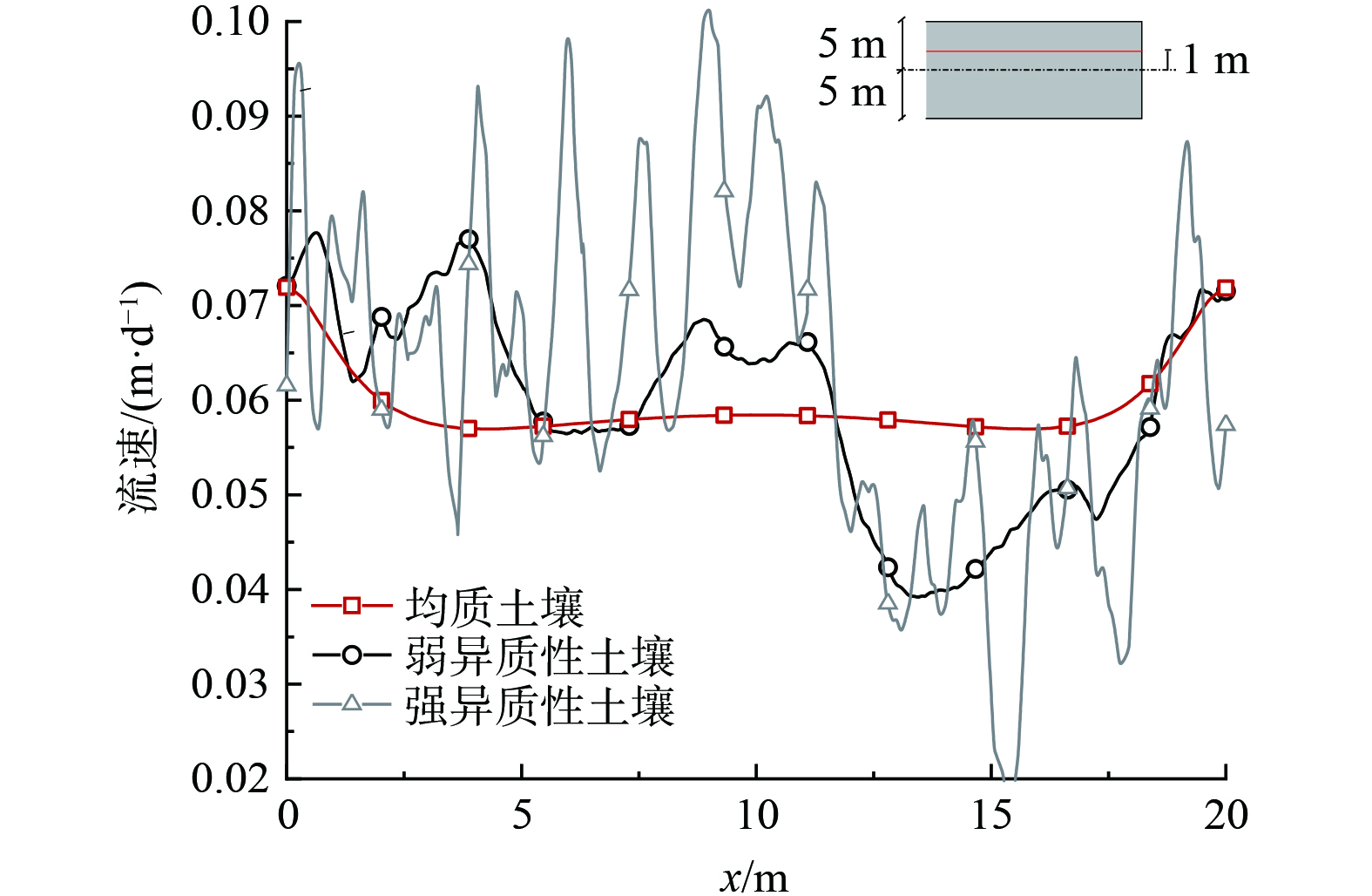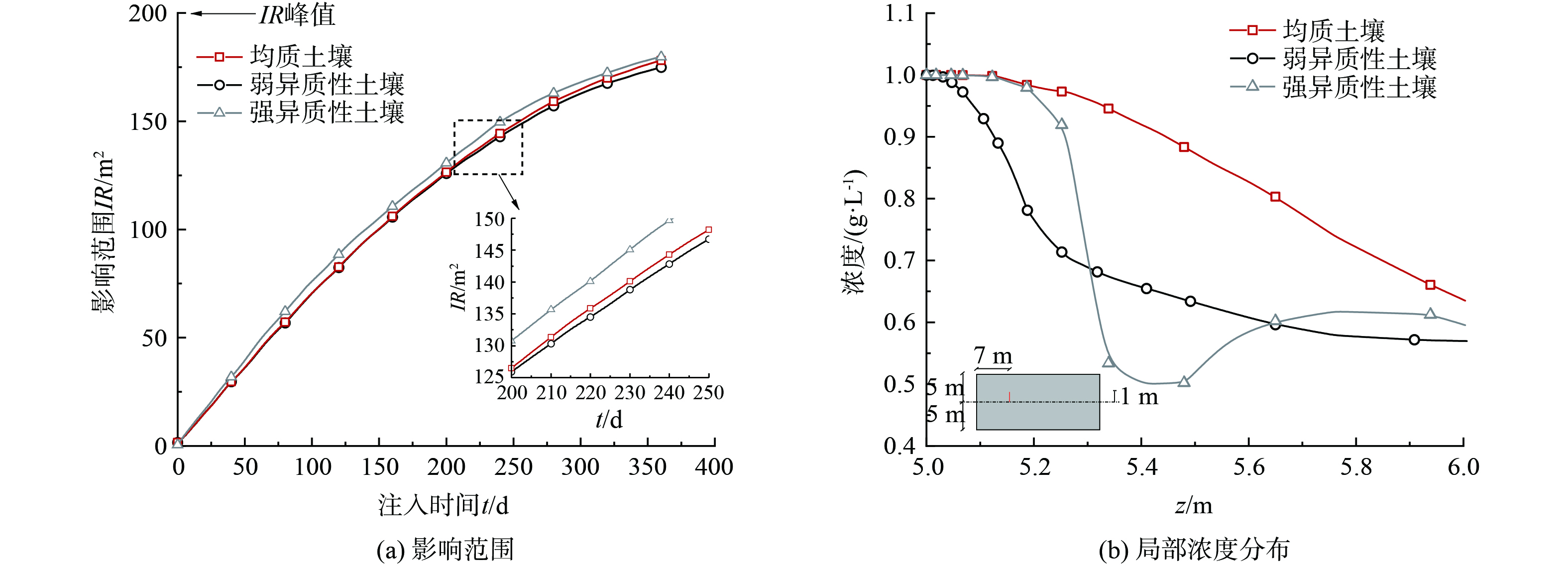-
有害物质如石油化工物质和其他有毒化合物的泄露或无序排放,污染临近土壤、地下水以及地表水体,对人类生活和环境健康构成了重大威胁,亟需对污染场地进行修复[1-3]。对于高渗污染场地而言,已经开发出了多种修复方法,如原位氧化和多相抽提等。原位氧化修复通过向污染场地中注入修复药剂,使得有害物质被氧化分解,从而减轻或消除污染[4-6]。而多相抽提则是一种物理修复方法,它通过改变土壤中的气压或水压促进污染物流动并抽出[7-8]。这些方法已在实践中得到了广泛的应用。然而,对于低渗场地 (K < 10−4 cm·s−1),由于极大的传质限制,原位氧化和多相抽提在提高修复药剂的注入和压力施加方面都存在很大困难[9-11]。
面对低渗场地修复的难题,水力压裂是一种有效的解决方案[11-14]。水力压裂是一种以高压液体注入低渗地层形成裂缝通道,从而提高其渗透性的技术[15-18]。在污染场地修复中,水力裂缝作为优渗通道可有效减小修复药剂与目标反应区的运移距离,从加快污染场地的修复速度、提高修复效率[13]。例如CHEN等[12]提出了多井注入条件下修复药剂强化输运的解析模型,分析了裂缝参数和注入参数对修复药剂运移特征的影响,发现裂缝中药剂浓度为均匀分布的线源时药剂利用率最高。此外,在水力压裂过程中,通过将修复药剂与裂缝支撑剂混合注入裂缝形成修复药剂夹层也可有效加快低渗污染场地修复。FENG和CHEN[14]的研究表明,修复药剂填充的裂缝 (称为反应性裂缝) 可作为内置修复药剂线源通过对流和扩散进入周围的低渗土壤基质,有效缩短了药剂源到达修复区域的距离。然而,现有研究中流场通常假设为自然水力梯度下的层流过程导致裂缝强化传质的机制仍不清晰。此外,场地异质性对修复药剂运移的影响也鲜有研究。
针对低渗污染场地,结合注入-抽提技术,构建了水力裂缝强化氧化药剂输运的数值模型。通过注入-抽提技术在场地形成稳定流场,对比了裂缝对场地压力、流速、药剂浓度分布的影响,揭示裂缝强化传质机制。通过地统计学方法生成随机渗透率场模拟场地异质性,将其嵌入构建的数值模型,研究渗透率的空间变异性对修复药剂注入-运移的影响,提出了异质性场地药剂注入策略的一般性建议。
-
图1为压裂低渗场地注入-抽提协同强化修复药剂输运的模型简图。如图所示,简化的水力裂缝贯穿整个场地,注入井和抽提井的井筛中心位于裂缝位置,并以等间距L排列。场地的深度为H,裂缝的孔径为b。坐标原点位于研究区域的左下角,x轴与裂缝平行,z轴与裂缝垂直。由于注入井与抽提井是周期等距排列,因此形成注-抽周期对称单元,如图1虚线框所示。为了降低计算量和简化模型,本研究仅探究周期对称单元内的修复药剂的运移情况。考虑对流、扩散、吸附和降解过程,修复药剂在裂缝和土壤中的运移控制方程见式(1)。
式中:下标i = m表示土壤基质,i = f表示水力裂缝;C是修复药剂的浓度,M·L−3;t是时间,T;λ是一阶降解速率,T−1;v是达西速度场,L·T−1;
$R = 1+\rho {K_d}/\theta $ 是阻滞因子,θ是孔隙率;Kd是吸附平衡系数,L3·M−1;ρ是土壤密度,M·L−3。D是水动力弥散系数张量,量纲为L2·T−1,计算方法见式(2)~式(4)。
式中:De是扩散系数;τ是迂曲因子;E是单位矩阵;Dd是弥散系数;αL是x方向弥散率,αT是z方向弥散率,T−1。
修复药剂注入过程中的渗流场由达西定律,见式(5)~式(6)。
式中:ρw是流体的密度,M·L−3;Qm是流场的源或汇项;K是介质渗透率,L−2;g是重力加速度,L−2·T−1;μ是流体粘度,M·L−1·T−1。
-
在氧化药剂注入之前,场地是完全饱和度,裂缝中和土壤基质中无氧化药剂存在,因此浓度初始条件和压力初始条件见式(7)~式(9)。
在氧化药剂注入过程中,1) 井筛位置的药剂浓度等于搅拌罐中药剂浓度C0,抽提井位置的出流通量取决于出口的流速和出口位置的药剂浓度; 2) 假设场地修复过程注入井和抽提井位置形成对称的注入和抽提流场,因此出井筛外,其上下位置均为Neumann边界; (3) 注入和抽提过程中均采用恒定压力控制。
式中:pin和pex分别是注入和抽提压力,Pa;H和L分别是计算土层的高度和宽度,L;η是注入和抽提井的筛孔范围,L;b是水力裂缝的孔径,L。修复场地的上边界是地面,下边界设置为不透水层,因此均为无通量边界。
裂缝与土壤基质界面满足浓度连续和通量连续条件,可知。
-
由式(5~6)可以看出,渗流场主要取决于场地的渗透率和压力,因此在模拟场地异质性时,渗透率场的异质性分布能够很大程度反映场地空间变异特征。半变异函数通常用于描述渗透率在空间上的变异性或相关性。它通过计算不同位置对之间的半变异值来反映样本点之间的空间相关性程度。半变异函数可以表示为式(22)。
式中:σ2 是方差;h是观测点之间的距离;n是块金常数。ρ (h) 是自相关函数,经典的自相关函数包括高斯模型、指数模型、球状模型等。高斯型自相关函数和协方差函数可以表示为式(23~24)。
式中:s是用于调整模型表现的缩放因子;l是相关长度,表征随机场的空间相关性在空间距离上的衰减程度。指数型自相关函数和协方差函数可以表示为式(25~26)。
值得注意的是本研究提到的半变异函数或自相关函数均为弱平稳形式,即假设随机场的均值和方差在整个空间区域内保持不变,协方差函数只与空间距离相关,而与具体的位置无关。换句话说,弱平稳假设允许随机场的统计特性随着空间位置的变化而发生改变,但只要空间距离相同,协方差函数就保持不变。一般来说,弱平稳假设提供了更灵活的建模方式,适用于更多实际场景的数据分析和预测。另一方面,从式(23~24)和式(25~26)可知,指数模型假设半变异值与距离之间呈指数衰减的关系,适用于具有快速减少的空间相关性的情况,而高斯模型假设半变异值与距离之间呈高斯分布的关系,适用于具有光滑且对称的空间相关性的情况。因此,指数模型更适应于描述渗透率的空间变异性,将用于本研究的随机渗透率场的生成。
-
由图1可知,对于一个注-抽周期单元,注入井和抽提井的中轴线可作为对称边界处理,井筛位于边界中间部位,修复药剂在压力的作用下从注入井筛进入土层,然后在注-抽形成稳定渗流场的作用下运移至抽提井。图2显示了低渗场地和压裂后低渗场地中修复药剂注入90 d后的浓度分布情况。相关参数见表1。可以看出,水力裂缝的存在显著增大了修复药剂的运移范围。一般而言,修复药剂的注入效果可通过影范围IR表征,计算如下。
如图2(a)和2(b)所示,以0.25 g·L−1轮廓线为例,相同条件下低渗场地注入修复药剂90 d的影响范围是33.2 m2,而压裂后形成1 cm孔径的水力裂缝后,影响面积为63.9 m2,提高了92.5%。这是由于裂缝的高导流能力在低渗场地中形成了优渗通道,如图2(b)中的子图,裂缝浓度远远高于周围土壤基质中的药剂浓度。另一方面,由于裂缝的高渗特性,也改变土壤中的压力分布。图3显示了低渗场地和压裂场地中,在注入和抽提作用下,场地水压的分布特征。以300 kPa轮廓线为例,低渗场地中压力的影响范围是12.5 m2,而对于压裂场地,压力的影响范围提高到了52 m2,这说明水力裂缝可作为低阻力通道,显著提高注入-抽提压力的有效作用范围。
根据达西定律可知,土壤基质中压力的增大会提高对流速率。如图4(a)中对比了低渗场地中轴线上方1 m位置的流速分布。注意裂缝周围1 m位置的药剂浓度是衡量裂缝强化传质的关键参考位置,因为当距离超过1 m后浓度会迅速衰减并显著低于所需浓度。可以看出,低渗场地中,在注入井和抽提井附近3 m以内的位置,由于压力积聚 (图3(a)) ,流速显著高于压裂场地,随后流速迅速衰减至0.03 m·d−1。而对于压裂场地,由于裂缝的低阻力特性,有效促进了压力的传播,因此井附近的流速相对无压裂场地稍低,且随远离井筛距离的增大,流速衰减的幅度明显减小。整体上,低渗土壤水力压裂后,土壤基质中流速提高了近2倍。此外,图4(b)还评估了两种不同工况下修复药剂影响范围的时变特征。可以看出,压裂后修复药剂影响范围始终高于无裂缝的低渗工况。此外,压裂场景中影响范围的增速在后期有降低的趋势。这是由于研究域的尺寸为20 m×10 m,因此影响范围的峰值为200 m2,当修复药剂的影响范围接近该峰值时,药剂会向抽提井收敛,因此速率降低。整体上,当药剂注入时间为90 d时,孔径为1 cm的单裂隙对低渗场地中修复药剂影响范围提升92.5%,当注入320 d时,影响范围提高了50%左右。
-
大多数的模型均将土壤简化为均质连续模型,然后现实中土壤具有显著的空间变异性,包括土壤密度、土壤矿物成分、孔隙率和渗透率等。在污染场地修复过程中,渗透率对修复药剂和污染物的运移影响最为显著。因此,本节主要研究注入-抽提条件下,渗透率的空间变异性对修复药剂运移和分布的影响。
图5显示了结合式(22)和式(25~26)通过python程序生成的随机渗透率场。生成随机渗透率K场后,通过卷积运算对随机场进行平滑处理以消除不连续性或间断点。这里使用的卷积核是一个均匀分布的矩阵,所有的元素值都相等,且元素之和等于1。离散数据集的卷积运算可表示如下。
式中:i和j是随机K场的数据位置;m和n是卷积矩阵中的元素位置;M和N是卷积核的尺寸,尺寸越大,平滑效果越好。当M=N时,卷积核为正方形,可以确保卷积操作在所有方向上的效果是一致的,这正是本节使用的方法。对于低渗场地,10 mD (=1×10−14 m2) 是本研究使用的渗透率,首先使用地统计法对logK进行随机场生成,期望为1,方差为0.5。通过0.5和1.5尺寸的卷积核对生成的随机场进行平滑处理,然后换算得到随机渗透率K场。图5(a)是卷积核尺寸为1.5平滑处理后低异质性随机K场的分布特征,期望为1×10−14 m2,方差是3.92。图5(b)是卷积核尺寸为0.5平滑处理后强异质性随机K场的分布特征,期望为1×10−14 m2,方差是57.16。
通过将生成的随机K场数据导入COMSOL Multiphysics 6.0,研究修复药剂在注入-抽提作用下的运移域分布特征。模型参数除K值外均与表1中的参数相同。图6显示了未压裂 (a和b) 和压裂条件下 (c和d) ,弱异质场地和强异质场地中修复药剂注入90 d后的分布特征。与均质相比 (图2) ,图6(a)和图6(c)中的修复药剂分布呈现明显的差异性分布,且0.25 g·L−1的轮廓线也不再是光滑的曲线。而对于强异质性场地而言 (图6(b)和图6(d)) ,浓度分布的波动变得更加显著,0.25 g·L−1的轮廓线也更加粗糙,且局部出现浓度聚集。对于不同异质性条件,相比于低渗土壤 (图6(a)和图6(b)) ,压裂后 (图6(c)和图6(d)) 药剂注入90 d的影响范围显著提高,与图2类似。渗透率K场的空间变异性对渗流场的影响如图7所示。与均质场地相比,异质性场地的流速分布出现了明显的波动,且异质性越大波动越显著。值得注意的是局部流速的变化会影响修复药剂与土壤颗粒的相互作用,如吸附-解吸过程,较高的流速会削弱这种传质过程,因此可能导致修复药剂吸附浓度分布的异质性。
图8(a)对比了均质场地、弱异质性场地和强异质性场地中修复药剂影响范围的时变特征。可以发现,不同场地条件下修复药剂的影响范围的变化趋势无明显差异,且不同注入时间的影响范围IR差异也并不显著。以注入90 d为例 (图2(b)、6(a)、6(b)) ,均质场地、弱异质性场地和强异质性场地的影响范围分别是63.9、63.7和69.1 m2。这说明均质简化模型对于影响范围的评估具有一定的可靠性。然而应当注意的是,异质性会导致修复药剂的分布产生显著的空间变异性。图8(b)显示了连续注入90 d,距离注入井7 m位置土壤中修复药剂的浓度分布。可以看出,与均质场地相比,弱异质性场地的浓度较低。而对于强异质性场地而言,浓度波动较大,可能造成修复药剂出现局部过量或不足的情况,因此造成修复药剂的浪费或污染物修复效率不高的弊端。例如,假设该污染场地为达到修复目标药剂浓度至少应为0.7 g·L−1,那么图8(b)中z = 5.4 m位置处,弱异质性场地药剂缺失率为7.14%,而对于强异质性场地药剂缺失率达28.57%。总而言之,在污染场地修复的过程中,在评估污染物分布和修复药剂的用量时应考虑场地的异质性。需要说明的是,为了提高计算效率本文生成渗透率随机场使用了较小的方差 (σ2 = 0.5) ,然而实际工程中地质特性统计学方差同样存在较大的情况,因此未来需要更加深入的研究。此外,由于篇幅有限,本研究没有详细研究裂缝性质 (如裂缝迂曲形态,裂缝孔径、裂缝表面粗糙度) 对药剂输运的影响,为更加全面和深入理解裂缝影响机制,未来工作中这些因素的详细分析是十分必要的。
-
1) 与低渗场地相比,水力裂缝可通过增强场地压力传递能力提高渗流速率,从而强化药剂输运。此外,裂缝可作为优渗通道优先形成药剂线源然后与周围土壤基质通过质量交换强化药剂输运。例如低渗污染场地中水力压裂形成孔径为1 cm的单裂隙条件下,药剂连续注入90 d时影响范围提高92%;药剂连续注入320 d时,影响范围提高50%左右。
2) 与均质场地相比,异质性场地中修复药剂出现显著的浓度波动,且异质性越强,浓度差异性越明显,浓度轮廓线越粗糙。此外,异质性还显著影响场地的渗流场分布,强异质性通常对应达西速度的高波动分布,并潜在地影响土壤的传质过程。
3) 就影响范围的评估而言,均质简化模型与异质性模型 (σ2 = 0.5) 的差异并不明显,但是在评估污染物的分布特征和修复药剂的用量时需要着重考虑异质性的影响,因为异质性场地会出现污染物或修复药剂的局部累积。从业者在指定修复方案时如果忽略异质性的影响可能导致修复药剂出现局部过量或不足的情况,因此造成修复药剂的浪费或污染物修复效率不及预期。例如,当假设该污染场地为达到修复目标药剂浓度至少为0.7 g·L−1时,弱异质性场地特定位置的修复药剂缺失率为7.14%,而对于强异质性场地药剂缺失率达28.57%。
低渗污染场地水力压裂强化修复药剂输运机制
Mechanisms of amendment transport in low-permeability contaminated sites enhanced by hydraulic fracturing
-
摘要: 由于低渗透污染场地较低的渗透特性极大限制了修复药剂的注入和运移,导致传统修复方法的治理效率低下。水力压裂作为强化传质的有效手段已得到广泛认可。因此结合注入-抽提技术,构建了低渗污染场地中考虑水力压裂的修复药剂强化输运数值模型。该模型考虑了修复药剂输运的对流、扩散、吸附和降解机制,研究了水力裂缝对低渗场地中修复药剂运移的强化作用。并基于地统计学方法生成随机渗透率场以研究异质性对修复药剂输运和分布的影响。结果表明,水力裂缝可通过形成优渗通道、强化压力传递等方式有效促进修复药剂的运移,相比于低渗场地,压裂场地中修复药剂的影响范围至少增大50%;场地的异质性会导致药剂浓度出现显著波动和局部浓度聚集,且波动程度随着异质性的增大而增强,因此造成弱异质性场地特定位置药剂缺失率在7.14%左右,而强异质性场地药剂缺失率高达28.57%。Abstract: Due to the low permeability characteristics of contaminated clay sites, the injection and migration of amendments are significantly hindered, leading to a reduced efficiency of traditional remediation methods. Hydraulic fracturing, as an effective means of enhancing mass transfer, has been widely recognized. Hence, in conjunction with the injection-extraction technique, this study developed a numerical model for the enhanced transport of amendments in low-permeability contaminated sites by hydraulic fracturing that considers the convection, diffusion, adsorption, and degradation mechanisms and investigates the enhancing role of hydraulic fractures in the transport of amendments in low-permeability environments. Based on geostatistical methods, a random permeability field was generated to study the influence of heterogeneity on the transport and distribution of amendments. The results indicate that hydraulic fractures can effectively promote the migration of amendments by forming preferential flow paths and intensifying pressure transmission. Compared to low-permeability sites, the influence range of amendments in fractured sites increased by at least 50%. The heterogeneity of the site leads to significant fluctuations in the concentration of amendments and localized concentration accumulations and the degree of fluctuation increases with the increase in heterogeneity. As a result, this results in a location-specific amendment missing rate of around 7.14% for weakly heterogeneous sites and up to 28.57% for strongly heterogeneous sites.
-

-
表 1 本研究使用的模型参数
Table 1. Model parameters in this study
参数符号 参数值 参数含义 H 10 m 深度 L 20 m 长度 b 0.01 m 裂缝孔径 θm 0.35 土壤孔隙率 θf 0.8 裂缝孔隙率 Dm 1×10−9 m2·s−1 土壤中扩散系数 Df 1×10−8 m2·s−1 裂缝中扩散系数 Km 1×10−14 m2 土壤固有渗透率 Kf 1×10−8 m2 裂缝固有渗透率 pin 700 kPa 注入压力 pex 700 kPa 抽提压力 R 1.0 阻滞因子 λm 1×10−11 s−1 土壤中一阶降解系数 λf 1×10−10 s−1 裂缝中一阶降解系数 η 0.2 m 井筛高度 C0 1 g·L−1 修复药剂浓度 n 1.0 随机场logK期望 σ2 0.5 随机场logK方差 l 0.1 相关长度 s 1.0 缩放因子 M1 0.5 卷积核尺寸 (强异质性) M2 1.5 卷积核尺寸 (弱异质性) -
[1] LIU L, LI W, SONG W, et al. Remediation techniques for heavy metal-contaminated soils: Principles and applicability[J]. Science of the Total Environment, 2018, 633: 206-219. doi: 10.1016/j.scitotenv.2018.03.161 [2] DING X H, FENG S J, ZHENG Q T. A two-dimensional analytical model for contaminant transport in a finite domain subjected to multiple arbitrary time-dependent point injection sources[J]. Journal of Hydrology, 2021, 597: 126318. doi: 10.1016/j.jhydrol.2021.126318 [3] 潘云飞, 唐正, 彭欣怡, 等. 石油烃污染土壤微生物修复技术研究现状及进展[J]. 化工进展, 2021, 40(8): 4562-4572. [4] ZHOU Z, LIU X, SUN K, et al. Persulfate-based advanced oxidation processes (AOPs) for organic-contaminated soil remediation: A review[J]. Chemical Engineering Journal, 2019, 372: 836-851. doi: 10.1016/j.cej.2019.04.213 [5] 章生卫, 程小谷, 于李罡, 等. 石油烃污染地下水原位化学氧化修复研究[J]. 环境科学与技术, 2021, 44(S1): 56-60. [6] USMAN M, JELLALI S, ANASTOPOULOS I, et al. Fenton oxidation for soil remediation: A critical review of observations in historically contaminated soils[J]. Journal of Hazardous Materials, 2022, 424: 127670. doi: 10.1016/j.jhazmat.2021.127670 [7] QI S, LUO J, O'CONNOR D, et al. A numerical model to optimize LNAPL remediation by multi-phase extraction[J]. Science of the Total Environment, 2020, 718: 137309. doi: 10.1016/j.scitotenv.2020.137309 [8] KACEM M, BENADDA B. Mathematical model for multiphase extraction simulation[J]. Journal of Environmental Engineering, 2018, 144(6): 04018040. doi: 10.1061/(ASCE)EE.1943-7870.0001378 [9] REDDY K R, MATURI K, CAMESELLE C. Sequential electrokinetic remediation of mixed contaminants in low permeability soils[J]. Journal of environmental engineering, 2009, 135(10): 989-998. doi: 10.1061/(ASCE)EE.1943-7870.0000077 [10] 田蕾, 胡立堂, 张梦琳. 低渗透石化污染场地多相抽提修复效率的数值模拟[J]. 中国环境科学, 2022, 42(2): 925-935. [11] ZHAO S, ZHANG J, FENG S J. The era of low-permeability sites remediation and corresponding technologies: A review[J]. Chemosphere, 2022: 137264. [12] CHEN H, FENG S J, ZHENG Q T, et al. Enhanced delivery of amendments in fractured clay sites based on multi-point injection: An analytical study[J]. Chemosphere, 2022, 297: 134086. doi: 10.1016/j.chemosphere.2022.134086 [13] CHEN, H. , FENG, S. J. Evaluation and application of fractal-based hydraulic constitutive model for unsaturated flow in heterogeneous soils[J]. Computers and Geotechnics, 2023, 159: 105497. doi: 10.1016/j.compgeo.2023.105497 [14] FENG S J, CHEN H. Enhanced delivery of amendments in contaminated low-permeability soils by hydraulic fracturing[J]. Journal of Hydrology, 2023, 622: 129678. doi: 10.1016/j.jhydrol.2023.129678 [15] MURDOCH L C. Hydraulic fracturing of soil during laboratory experiments Part 1. Methods and observations[J]. Geotechnique, 1993, 43(2): 255-265. doi: 10.1680/geot.1993.43.2.255 [16] WANG S Y, SUN L, AU A S K, et al. 2D-numerical analysis of hydraulic fracturing in heterogeneous geo-materials[J]. Construction and Building Materials, 2009, 23(6): 2196-2206. doi: 10.1016/j.conbuildmat.2008.12.004 [17] CHEN S S, SUN Y, TSANG D C W, et al. Insights into the subsurface transport of As (V) and Se (VI) in produced water from hydraulic fracturing using soil samples from Qingshankou Formation, Songliao Basin, China[J]. Environmental Pollution, 2017, 223: 449-456. doi: 10.1016/j.envpol.2017.01.044 [18] BJERRUM L, NASH J, KENNARD R M, et al. Hydraulic fracturing in field permeability testing[J]. Geotechnique, 1972, 22(2): 319-332. doi: 10.1680/geot.1972.22.2.319 -




 下载:
下载:









